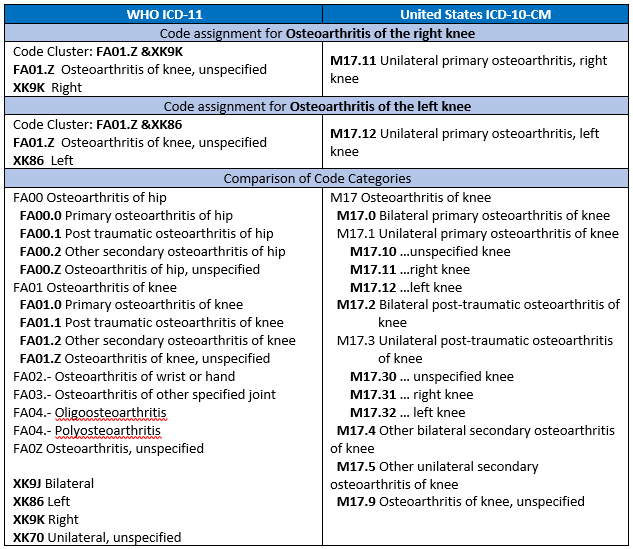While implementation of ICD-11 in the US is likely years away, it is not too early to become familiar and comfortable with the structure and format. ICD-11 is a digital classification that is very different from ICD-10-CM.
Let’s compare and contrast coding of a common condition, osteoarthritis.

Note:
- – These code assignments reflect the closest equivalent code from each code set as of April 2023.
- – Code category comparisons reflect excerpts from the ICD-11 Browser compared to the ICD-10-CM Tabular listing.
In this example, the ICD-11 code is “post-coordinated” to create a “code cluster” that reflects both the type of osteoarthritis and laterality. The concepts of pre-coordination and post-coordination are important in ICD-11. Pre-coordinated concepts are represented by one code that fully reflects the condition. All ICD-10-CM codes are pre-coordinated. However, ICD-11 has both pre- and post-coordinated codes. Post-coordination is used to link codes together. In this way, you can capture details of a condition, even when those details aren’t already included in one combination code. ICD-10-CM has thousands of pre-coordinated combination codes, whereas ICD-11 has very few. As shown in the table, there are four ICD-11 stem codes for osteoarthritis of the knee, whereas ICD-10-CM has eleven different codes.
You’ll notice the organization of the code categories is also different between the code sets. In ICD-10-CM, osteoarthritis of one knee (i.e., unilateral unspecified, right, or left) is presumed to be primary osteoarthritis, even if clinical documentation does not specify that it’s primary. ICD-11 does not make this assumption.
I’ll share additional examples of ICD-11 post-coordinated code clusters in future blogs. So, stay tuned.
You can also go to the WHO website and use the ICD-11 coding tool to see a variety of “stem” codes and “extension” codes that can be post-coordinated together in a cluster.
Mary H. Stanfill is Vice President of Consulting for United Audit Systems, Inc. and is the official representative of the IFHIMA to the WHO Family of International Classifications Education and Implementation (EIC) and Morbidity Reference Group (MbRG) workgroups. She has over 35 years of experience in the health information profession, primarily focused on clinical classification of healthcare data. She holds a masters in biomedical informatics and is currently pursuing a doctorate in health informatics.
Email: mstanfill@uasisolutions.com